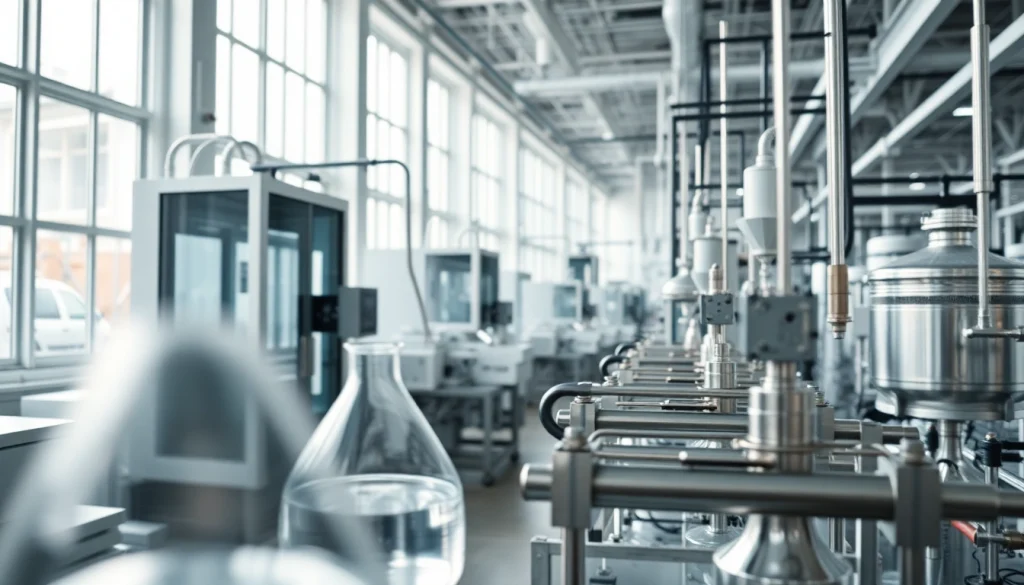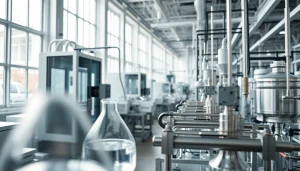Optimizing Operations in a Cellulose Ether Factory for Enhanced Quality and Efficiency

Understanding the Role of Cellulose Ether Factory in Modern Industry
In the rapidly evolving world of manufacturing, the role of specialized chemical compounds such as cellulose ethers cannot be underestimated. These substances find applications across various industries due to their unique properties, which enhance product functionality and performance. Whether in construction materials, personal care products, or pharmaceuticals, cellulose ethers play a vital role. The Cellulose ether factory is essential in ensuring the consistent production of these compounds, enabling manufacturers to meet the growing demand while maintaining high-quality standards.
The Importance of Cellulose Ethers in Manufacturing
Cellulose ethers, derived from natural cellulose, are versatile compounds that serve multiple functions in manufacturing processes. As water-soluble polymers, they help in thickening, stabilizing, and providing viscosity to a wide range of products. Their importance is particularly notable in industries like construction, where they improve the workability and water retention of mortars and plasters, ensuring an enhanced application experience.
In the realm of personal care, cellulose ethers contribute to the formulation of cosmetics, offering desirable textures and helping control the release of active ingredients. Additionally, their role in pharmaceuticals is critical, where they act as binders and film-forming agents, ensuring optimal drug delivery and patient compliance.
Key Materials Used in a Cellulose Ether Factory
The manufacturing of cellulose ethers requires an array of raw materials and chemicals. The primary source is natural cellulose, which is extracted from wood pulp or cotton. The choice of cellulose impacts the quality and properties of the final product. Essential reagents used in the reaction include alkali (such as sodium hydroxide) and etherifying agents (like ethylene oxide or propylene oxide), which convert the cellulose into cellulose ether through a series of carefully controlled chemical reactions.
Furthermore, additives such as preservatives and stabilizers are also utilized to enhance the shelf life and functional attributes of the products. Understanding the chemical and physical properties of these materials is crucial for a cellulose ether factory to produce high-quality compounds that meet specific specifications.
The Manufacturing Process Explained
The manufacturing of cellulose ethers involves several key steps: sourcing of raw materials, chemical modification of cellulose, purification, and drying. Initially, natural cellulose is dissolved in an alkaline solution to create alkali cellulose, which undergoes etherification with chemical reagents. This process modifies the cellulose structure, resulting in various types of cellulose ethers such as methylcellulose, hydroxypropyl methylcellulose, and carboxymethyl cellulose.
Following etherification, the treated cellulose is washed and purified to remove unreacted and residual chemicals. The purification stage is essential to ensure the product is suitable for its intended applications. Finally, the cellulose ether undergoes drying to achieve the desired form—either as a powder or granulate—before being packaged for distribution to manufacturers worldwide.
Best Practices for Quality Control in a Cellulose Ether Factory
Implementing Quality Assurance Protocols
In the production of cellulose ethers, maintaining high quality is paramount. Implementing robust quality assurance (QA) protocols is essential. Quality checks must start from the raw material phase, ensuring that the cellulose sourced meets stringent industry standards. Regular testing for contaminants, moisture content, and other critical properties should be conducted throughout the manufacturing process.
In-process monitoring of chemical reactions is also vital to avoid inconsistencies in the products. Utilizing statistical process control (SPC) techniques can help manage variability and uphold quality standards. A dedicated quality control team should be involved in the process, conducting routine audits and inspections.
Using Advanced Technology for Quality Monitoring
Integrating advanced technologies such as real-time analytics and automation can significantly enhance quality monitoring in a cellulose ether factory. Incorporating sensors and data collection devices allows for precise tracking of parameters like temperature, pressure, and reaction times during production. Artificial intelligence (AI) can further analyze data trends, identifying potential quality issues before they affect the final product.
Moreover, utilizing laboratory equipment such as high-performance liquid chromatography (HPLC) and Fourier-transform infrared spectroscopy (FTIR) can help characterize the chemical structure and confirm the quality of the cellulose ethers produced.
Regular Audits and Compliance Checks
Conducting regular audits is a critical component of maintaining quality in manufacturing. A cellulose ether factory should schedule systematic audits of production processes, quality control procedures, and compliance with environmental and safety regulations. Compliance with international standards such as ISO 9001 can enhance sustainable production practices and consumer confidence.
Moreover, engaging third-party inspectors can bring an objective perspective to the quality control process. This ensures that factories are meeting all necessary regulatory requirements and continuously improving their production practices.
Efficiency Strategies for Operating a Cellulose Ether Factory
Streamlining Production Processes
Efficiency within a cellulose ether factory can be achieved through process optimization. Mapping out the entire production process allows management to identify bottlenecks, redundancies, and areas that can be improved. Lean manufacturing principles, such as reducing waste and maximizing resource utilization, can significantly enhance production efficiency.
For instance, optimizing batch sizes and scheduling can reduce idle time between production runs. Furthermore, implementing continuous flow production, where materials move seamlessly from one stage to another, can expedite manufacturing and reduce costs.
Energy Conservation Techniques
Energy consumption is a significant concern for any manufacturing operation. Adopting energy conservation techniques can reduce operational costs and lessen the environmental impact. Implementing modern technologies such as energy-efficient motors, variable frequency drives, and smart energy management systems can help monitor and control energy usage throughout the manufacturing process.
Moreover, investing in renewable energy sources, such as solar panels or wind turbines, can contribute to sustainable operations, ultimately leading to long-term savings while enhancing the company’s green credentials.
Optimizing Supply Chain Management
A well-managed supply chain is crucial for the efficiency of a cellulose ether factory. Establishing strong relationships with suppliers can ensure a steady flow of high-quality raw materials. Moreover, utilizing supply chain management software can provide insights into demand forecasting, inventory management, and logistics planning.
Implementing Just-In-Time (JIT) inventory practices can minimize holding costs and reduce waste. By ensuring that materials arrive precisely when needed in production, manufacturers can streamline operations and enhance efficiency.
Innovations and Future Trends in Cellulose Ether Production
The Impact of Industry 4.0 on Manufacturing
The shift towards Industry 4.0, characterized by the integration of smart technologies and automation, is revolutionizing manufacturing, including the cellulose ether sector. Utilizing the Internet of Things (IoT) allows factories to connect machines, devices, and processes, providing valuable data insights that can lead to improved decision-making.
Moreover, predictive maintenance powered by artificial intelligence can foresee equipment failures before they occur, thus minimizing downtime and maintenance costs. Adopting these innovations will not only boost efficiency but also enhance product quality in cellulose ether production.
Eco-Friendly Practices in a Cellulose Ether Factory
The growing emphasis on sustainability has led cellulose ether factories to adopt eco-friendly practices. This includes the sourcing of renewable materials and the implementation of waste management systems that recycle by-products from production processes. Furthermore, utilizing biobased solvents and energy-efficient processes can minimize the environmental footprint associated with cellulose ether manufacturing.
Manufacturers are also focusing on life cycle assessments (LCAs) to measure the ecological impact of their products. This data can guide decision-making and provide consumers with transparency regarding the sustainability of the products they use.
Emerging Technologies in Product Development
The development of new cellulose ethers is shifting toward tailored solutions that meet specific customer needs. For example, advancements in nanotechnology have paved the way for the creation of cellulose ethers with enhanced properties, such as improved solubility and stability under varying environmental conditions.
Moreover, ongoing research into the utilization of sustainable sources for cellulose production, such as agricultural waste, is leading to innovative applications and formulations in industries ranging from food to energy.
Measuring Performance and Ensuring Business Growth
Key Performance Indicators for Success
To ensure a cellulose ether factory operates successfully, identifying and tracking key performance indicators (KPIs) is essential. Metrics such as production yield, product quality rates, and operational efficiency provide insights into performance. Additionally, monitoring customer satisfaction levels and delivery timelines can help assess overall business health.
Evaluating these KPIs regularly allows management to spot trends, adjust strategies, and ensure that the factory continually meets its business objectives.
Customer Feedback and Market Trends
Open channels for customer feedback are crucial for products’ success, particularly in the specialized field of cellulose ethers. Engaging with customers to understand their needs, preferences, and challenges allows manufacturers to tailor their products and services. Regular surveys, focus groups, and analytics can provide actionable insights into market trends, aiding forecasting and ensuring responsiveness to changing customer demands.
Expanding Market Reach for a Cellulose Ether Factory
Finally, for a cellulose ether factory to thrive, strategic market expansion is necessary. This can involve exploring new geographical markets or investing in new industries that require cellulose ether applications. Establishing partnerships with distributors and leveraging digital marketing can facilitate this expansion.
Moreover, diversification of product offerings can reduce risks and enhance growth opportunities. By continuously innovating and responding to market demands, a cellulose ether factory can ensure its lasting success in an increasingly competitive landscape.







